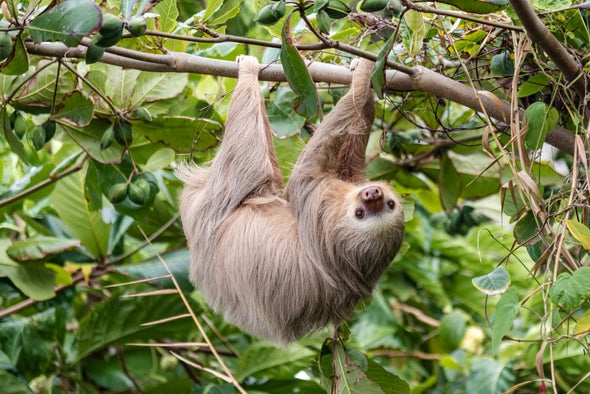(单词翻译:单击)
听力文本
This is Scientific American's 60-second Science, I'm Emily Schwing.
(Sloth sounds)
Somewhere in this forest you hear, there are sloths. Those sloths live in Brazill's Atlantic Forest. If you're a tourist, watching sloths isn't that exciting. But if you're a scientist—well, it's also not that exciting. But there's a big upside:
"So, they're actually a great study animal for the wild, because you can collect a lot of data on them."
Giles Duffield, a biologist at the University of Notre Dame, who studies circadian rhythms.
"I mean the ecology work that I used to do several years back in Bolivia was focused on bird conservation and bird ecology and, you know, you'd see some parrots and you'd make some notes and then they were gone and you wouldn't see them again for another 24 hours."
But Duffield and colleagues now collect data on the brown-throated three-toed sloth in the Atlantic Forest. Duffield says the sloths can stay in sight—or even in the same tree—for nearly 24 hours. The animals are at rest anywhere from 75 to 90 percent of the time. But they're coping with a damaged ecosystem.
"The suggestion is 98 percent of that forest has been depleted...there's a lot of human disturbance, there's a lot of roads cutting through these areas in the forest...and it means the fauna and flora is depleted."

According to new research published in the journal Mammalian Biology by Duffield and colleagues, sloths are responding to that habitat disturbance by altering their biological rhythms.
"We started to see that the sloths were primarily day-active and that seemed counterintuitive from some of the literature on the species that we'd come across before, that suggested that they show cathemeral activity, which is kind of neither day nor night, just kind of across the whole board. And in a few studies it was predominantly nocturnal behavior. So this was kind of the opposite to what we'd expected."
Duffield says there are few if any studies where researchers monitored sloths over a full 24-hour period. This study did exactly that for 29 days.
"Because a lot of the literature that we reviewed that was associated with sloths, had examined only a partial 24 hours and so there was some inferences about their activity profiles over the course of the entire 24 hour period...so there was a bit of guesswork there."
Duffield believes that because predators in the Atlantic forest are extinct, and sloths don't have to compete with other species for resources, they've simply taken on a daytime, or diurnal, schedule.
"The light-dark cycle would be that primary cue, and that's what's kind of surprising that an animal can be nocturnal under some conditions and diurnal in the other."
Other organisms may come along for the slow ride--from the algae that live on sloths' fur to the insects that live alongside the unhurried mammals. Duffield says it's not clear if the new schedule adopted by sloths in the Atlantic forests also affects these creatures.
"That's something we'd love to examine, whether the local ecosystem and the associated organisms with the sloth, perhaps that changes? A lot of organisms can't readily change their day to night activity. You know, their survival strategy is based on one or the other, so it may well be that change or that association with daytime as opposed to nighttime, or cathemerality, does change some of the organisms that are associated with it."
Duffield's most important piece of equipment for this research may be a comfortable chair.
Thanks for listening for Scientific American's 60-second Science. I'm Emily Schwing.
参考译文
这里是科学美国人——60秒科学系列,我是埃米莉·施温。
(树懒的声音)
如果你在这片森林的某个地方听到这种声音,那里就有树懒。这些树懒生活在巴西大西洋森林里。如果你是游客,看到树懒并不会那么令人兴奋。但如果你是科学家,其实也没那么令人兴奋。但有一个很大的好处:
“因此,它们其实是一种很好的野生研究动物,因为你可以收集大量关于它们的数据。”
圣母大学研究昼夜节律的生物学家贾尔斯·达菲尔德说到。
“几年前我在玻利维亚进行的生态研究工作主要聚焦鸟类保护和鸟类生态学,你会看到一些鹦鹉,记下一些笔记,之后它们就飞走了,在接下来的24小时你不会再看到它们。。”
但达菲尔德和同事现在正在大西洋森林中收集褐喉三趾树懒的数据。达菲尔德表示,树獭可以在人们的视线中——甚至在同一棵树上——待近24小时。无论在任何地方,这些动物有75%到90%的时间都在休息。但它们正在应对被破坏的生态系统。
“这意味着98%的森林已经枯竭……由于很多人为干扰,许多道路穿过森林中的这些区域……这意味着动植物群已经枯竭。”
根据达菲尔德及其同事在《哺乳动物生物学》期刊上发表的最新研究,树獭通过改变生物节律来应对栖息地的干扰。
“我们开始看到树獭主要在白天活动,这似乎与我们之前看过的有关该物种的文献在常理上相悖,这表明它们展现出非固定活动,既不是白天活动也不是夜间活动,而是全天都有活动。有些研究显示,它们主要在夜间行动。因此这和我们此前的预期正好相反。”
达菲尔德表示,几乎没有研究人员对树懒进行全天候的监测。而这项研究这样做了29天。
“因为我们所回顾的许多与树懒有关的文献只研究了24小时中的部分时间,之后对树懒在整个24小时内的活动进行一些推断,所以文献中存在一些推测。”
达菲尔德认为,由于大西洋森林中的捕食者都已灭绝,而且树懒也不必与其他物种争夺资源,所以它们决定采用白天或者说日间活动时间表。
“光暗周期将是主要线索,动物在某些条件下可能是夜行性的,而在另一种条件下可能成为昼行性的,这有点令人惊讶。”
其他生物可能也一起减慢速度——从生活在树懒皮毛上的藻类到与这种悠闲的哺乳动物一起生活的昆虫。达菲尔德表示,目前尚不清楚大西洋森林树懒采用的新时间表是否也会影响到这些生物。
“这是我们想研究的问题,当地的生态系统和与树懒相关的生物是否会改变?许多生物体不能轻易地改变它们白天到晚上的活动。它们的生存策略是基于一种活动或另一种,因此很可能是这种变化或与白天而不是夜间的联系,或是与非固定性活动的联系,确实改变了一些与之相关的生物体。”
达菲尔德在这项研究中最重要的设备可能是一把舒适的椅子。
谢谢大家收听科学美国人——60秒科学。我是埃米莉·施温。
译文为可可英语翻译,未经授权请勿转载!
重点讲解
重点讲解:
1. cope with (成功地)处理,应付,对付;
Fit people are better able to cope with stress.
健康的人较能应付压力。
2. respond to 应对;作出回应;作出反应;
You can rely on him to respond to a challenge.
你可以信赖他,他懂得应付挑战。
3. come across 偶然发现;偶然遇见;
I've never come across hieroglyphics like the handwriting of Peter Smallwood.
我从未见过像彼得·斯莫尔伍德那么难辨认的笔迹。
4. as opposed to 而不是;
This exercise develops suppleness as opposed to strength.
这项锻炼不是增强力量,而是增强柔韧性的。
关注微信公众号【可可双语精读】,获取详细讲解内容


